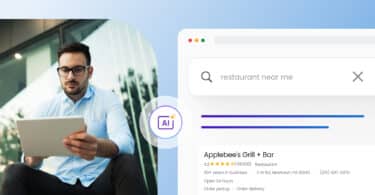Social media no longer relies solely on manual effort. The rise of AI has transformed how teams plan, publish, and respond, turning once enormous workloads into scalable workflows.
Summary
Drawing on first-party data from Birdeye’s State of Social 2026, which surveyed 300 multi-location businesses and 1,300 consumers, we've uncovered key new shifts in social strategy. In this blog, you’ll see how leading brands are adapting to these shifts, from posting cadences and content formats to reply-time benchmarks and consumer sentiment on AI-authored posts. We’ll also share five practical moves any team can use to build a scalable, modern content engine without burning out.
With these benchmarks in mind, let’s dive into how brands are adapting, from response times to AI-powered workflows.
Table of contents
- Summary
- Benchmarking the landscape: How brands show up today
- What formats do consumers actually engage with?
- Response times vs. customer expectations
- What’s slows down social media teams
- Where AI fits in the modern workflow
- AI in social media: How teams use it and how consumers feel
- Five moves to build a modern content engine
- FAQs
- Scale smarter with Birdeye Social AI
Benchmarking the landscape: How brands show up today
Over the past two years, challenges in social media have intensified: algorithms now prioritize short-form videos, creators are posting more frequently, and consumers expect near-real-time responses.
Let’s explore how often brands are posting and which formats actually capture attention.
Posting frequency: How often do brands appear?
According to Birdeye data, 42% of brands post a few times a week, 31% post multiple times a day, and 16% publish once daily. This means that a consistent cadence is now table stakes, but striking the right balance between volume and quality is what sustains growth.
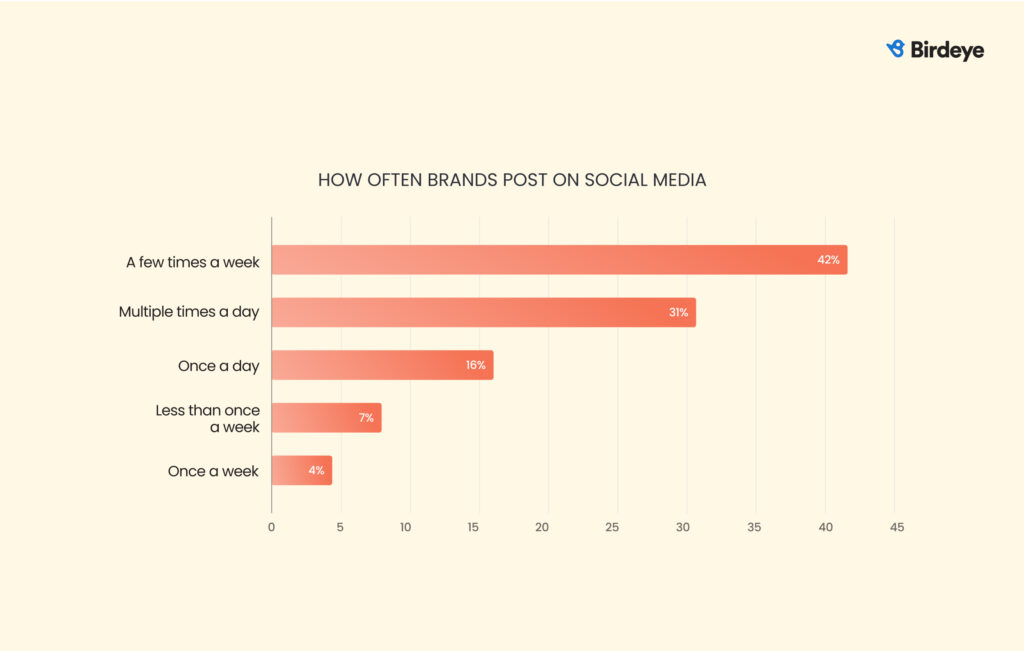
However, pushing for sheer volume often leads to fatigue. By the third or fourth post of the day, marketers may recycle ideas or post filler content just to meet a quota. The key takeaway here is that frequency maintains visibility, but it only delivers results when combined with content formats that truly engage your audience.
What formats do consumers actually engage with?
Consumers consistently engage the most with videos and photos, making them the two formats that dominate attention. Stories account for 13% of engagement, while articles, memes, and polls also earn steady interaction, albeit at lower rates.
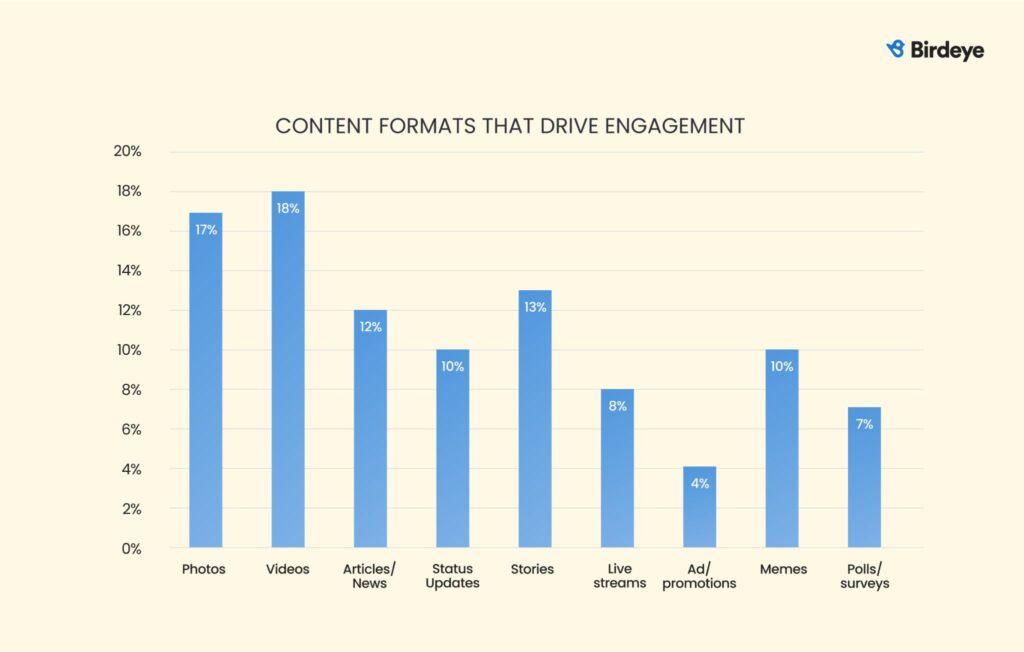
Short-form vertical video formats, such as Reels, TikToks, and Shorts, stand out as the most effective drivers of engagement. These formats feel native to mobile-first consumption and match the way people browse content. Photos, meanwhile, keep feeds visually active between videos, while Stories add continuity without requiring heavy production.
Key takeaways for brands looking to maximize engagement:
1. Prioritize videos as your anchor format and support it with high-quality photos.
2. Use Stories to stay visible between major posts without overwhelming your audience.
3. Pair text with visuals; plain text posts rarely perform on their own.
4. Reserve live streams and promotions for launches or campaigns where immediacy and impact are most crucial.
Consistency ensures visibility. Choosing the right format ensures that once you’re in the feed, you hold attention.
Response times vs. customer expectations
Posting is only half of the equation. Customers also judge brands by how quickly they respond to comments and direct messages. The data shows a clear gap: while 36% of customers expect a reply within an hour, only 24% of businesses currently meet that mark.
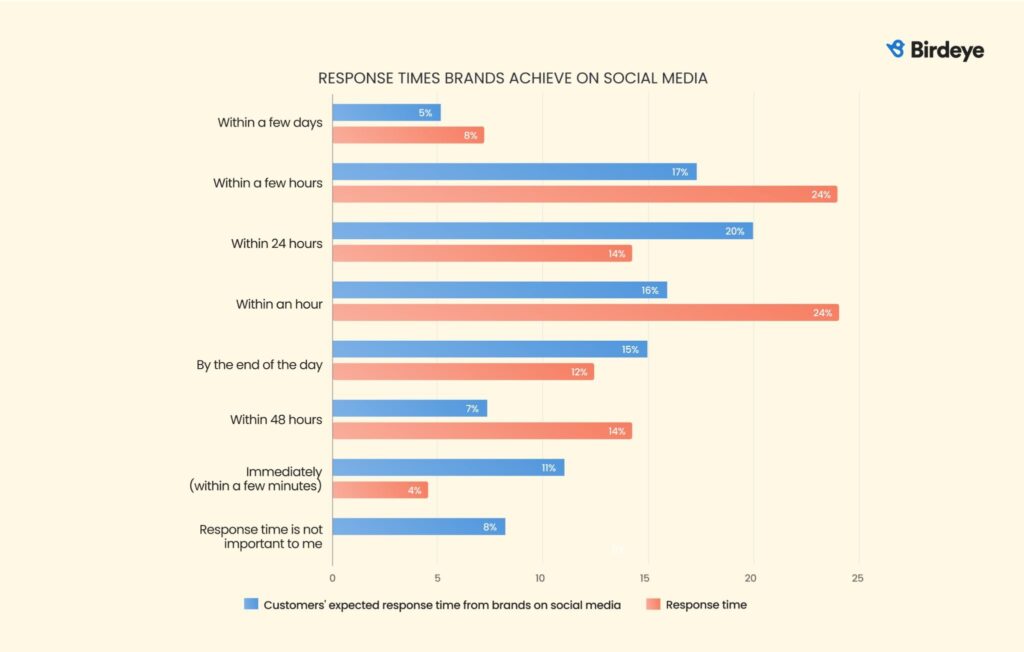
This gap matters. Delayed responses can weaken trust, frustrate customers, and even create openings for competitors to step in.
The good news is that teams don’t need to solve this manually. Tools like Birdeye Social AI allow businesses to manage comments and DMs at scale without overloading their teams.
What’s slows down social media teams
Scaling social content sounds simple on paper: post more, be present on multiple channels, and post frequently to be on top of mind. From finding the right ideas to producing videos, writing captions, and determining the best time to post, the process can quickly become demanding.
Key challenges in social media
Our research shows that teams struggle across every stage of the workflow: from brainstorming and producing videos to managing accounts across multiple locations. The single biggest blocker? Coming up with fresh ideas. That one task alone slows down nearly every part of the workflow.

The data confirms that without efficient ideation and coordination, even strong teams will lag. The fastest way to increase speed is by simplifying key steps: ideation, scheduling, and production.
Why manual posting persists and how to fix it
Despite all the challenges, a surprising number of businesses still rely on spreadsheets and manual publishing. This isn’t usually due to cost or complexity; it’s simply habit. Teams often feel that their current process works fine, but the hidden time lost in chasing files, resizing images, or copying posts across platforms adds up quickly.
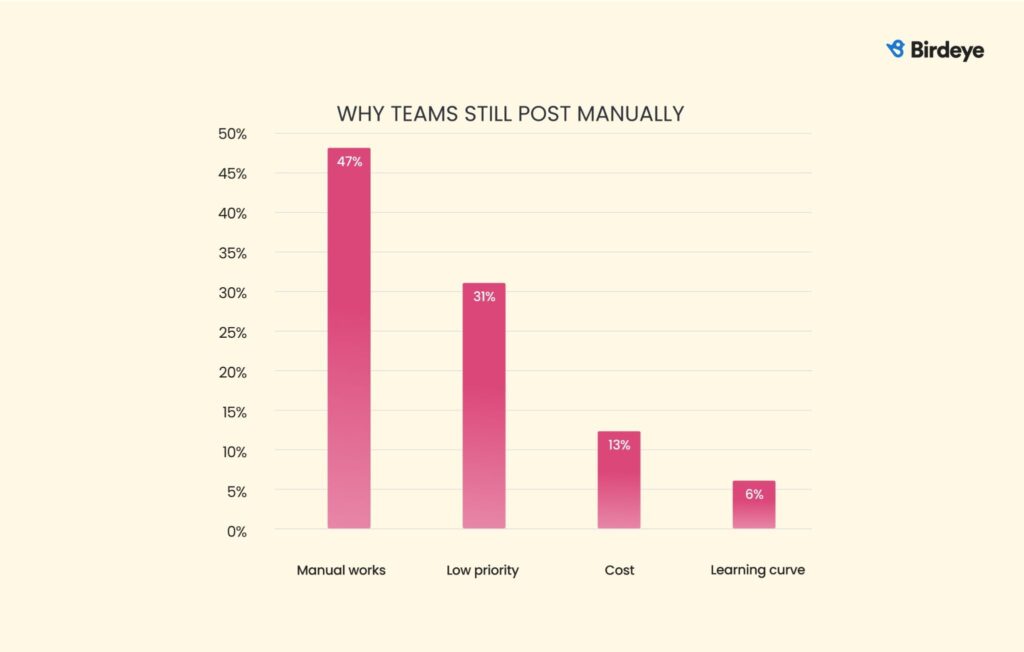
The fix isn’t just automation for its own sake. It’s about freeing up your team’s energy for creative, high-value work. When scheduling, approvals, and publishing live in a unified tool, the hours saved translate directly into better content and stronger results.
Where AI fits in the modern workflow
AI has moved beyond experimentation to become an everyday part of social media workflows. It now supports social teams across three critical touchpoints: ideation, drafting, and timing.
Ideation that beats the blank page
Instead of starting from scratch, teams use AI prompts to generate fresh ideas. For example, a marketer might ask, “Give me ten post ideas for National Pet Day aimed at dental patients in Dallas.” Within seconds, they have a tailored list to refine, saving hours of stalled brainstorming.
Drafting and editing that speed the first pass
Large language models can create first-draft captions, refine tone, and suggest hashtags. Marketers still edit for accuracy and brand voice, but the heavy lifting of getting words on the page is already done. That means less time stuck on blank screens and more time polishing content that connects.
Timing that optimizes delivery
AI-powered scheduling tools now recommend not only the right day, but also the exact minute a post is most likely to perform. These predictions use real-time audience activity heatmaps, helping brands publish when their followers are most engaged without relying on guesswork.
These examples highlight AI’s role in day-to-day execution. But zooming out, adoption rates and sentiment reveal how deeply AI is reshaping strategy, and how audiences are responding.
AI in social media: How teams use it and how consumers feel
As outlined above, AI now supports teams at key choke points like ideation, drafting, and scheduling. Zooming out, the bigger question is: how widespread is adoption, and how do both brands and audiences feel about this shift?
How brands use AI today
The majority of teams now rely on AI for repetitive but time-intensive tasks. Common uses include drafting posts, suggesting hashtags, and even preparing template responses to comments. By automating these building blocks, marketers free up more time for strategy, storytelling, and campaign design, the work that drives real differentiation.
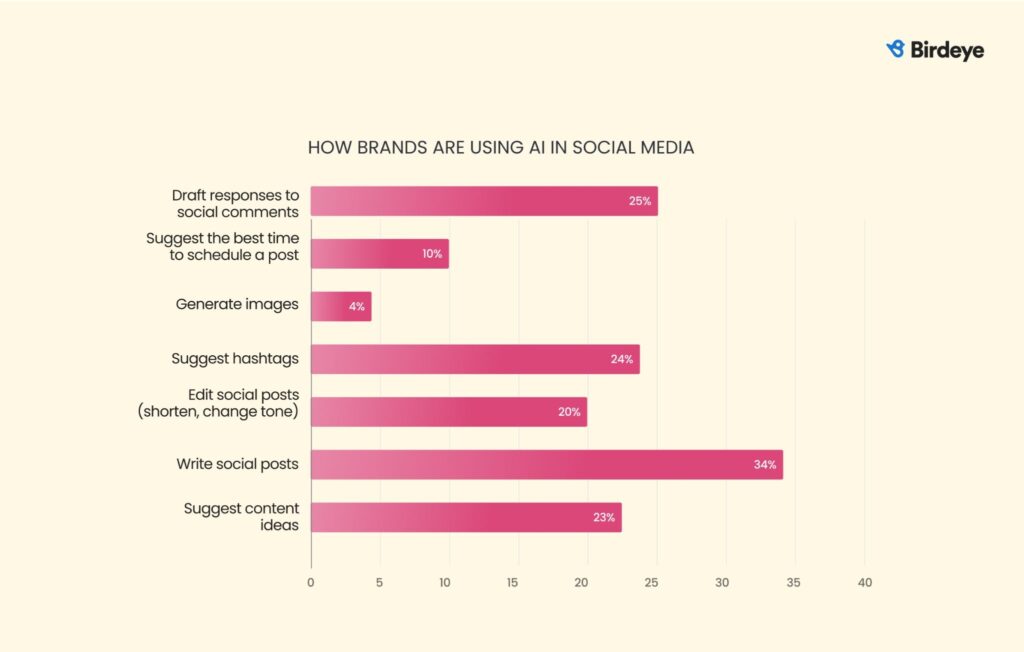
What impact does AI have on strategy?
AI’s influence is already reshaping how social teams operate. Teams report the biggest wins in saving time, boosting posting frequency, and improving customer support responsiveness. While not every use case delivers perfect results, the overall effect is clear: AI is helping social teams scale output without sacrificing quality.
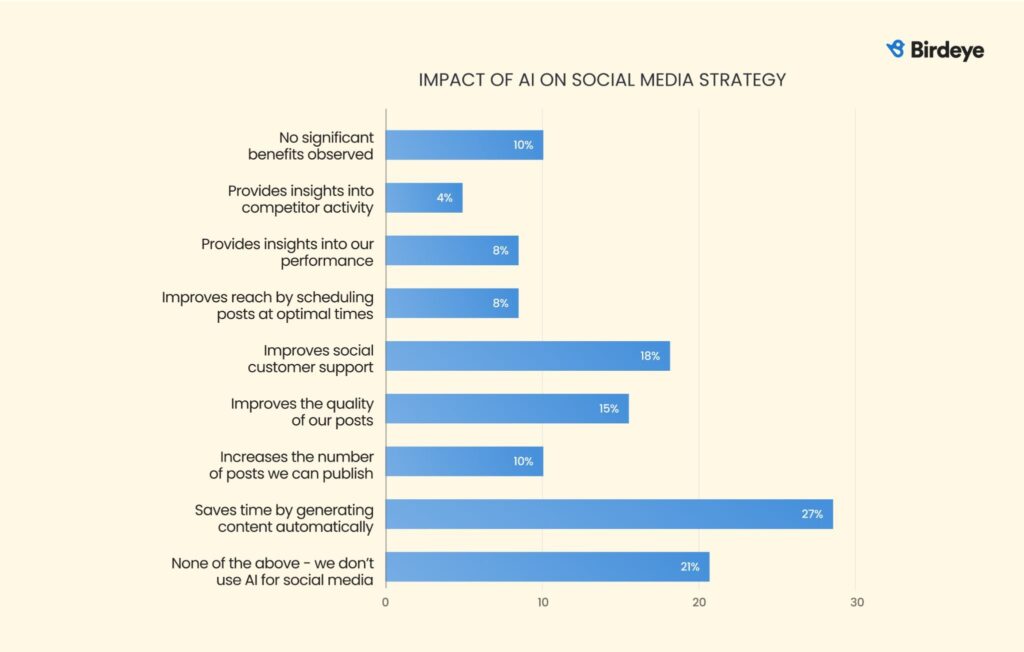
How consumers respond to AI-generated content?
Consumers take a more nuanced view. They’re quick to embrace AI when it enhances creativity or visual appeal, for example, producing eye-catching images or videos. But when AI steps into spaces that require empathy, like replying to comments or DMs, skepticism rises. Audiences are less forgiving if the content feels robotic or lacks transparency about its origins.
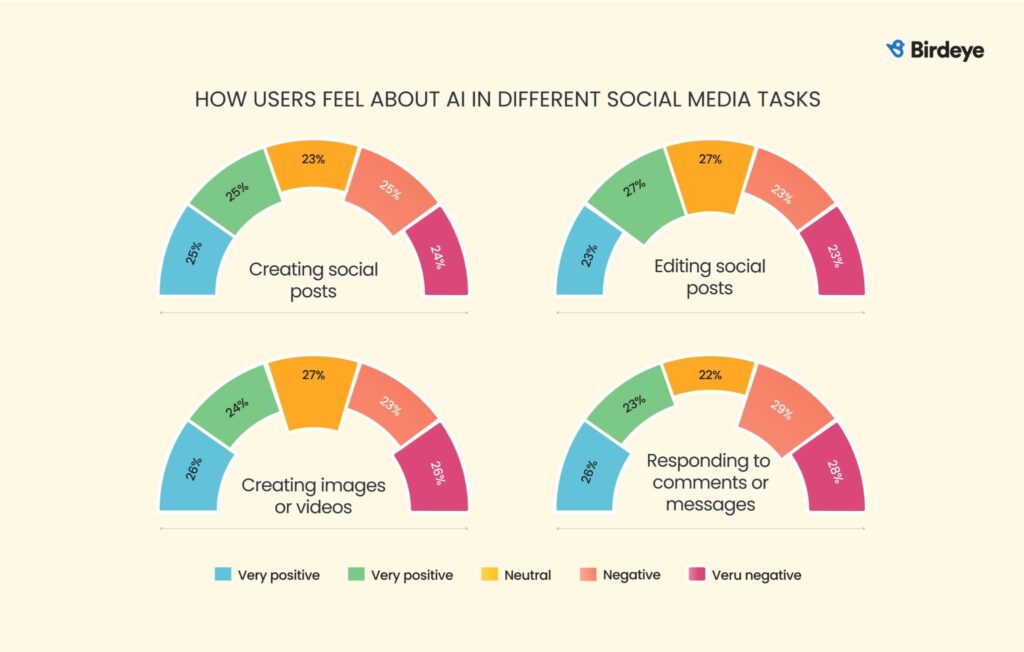
At a broader level, the picture is neither overly rosy nor sharply negative. Our data shows that 39% of users remain neutral toward AI-generated content, 27% lean positively, and 34% lean negatively.
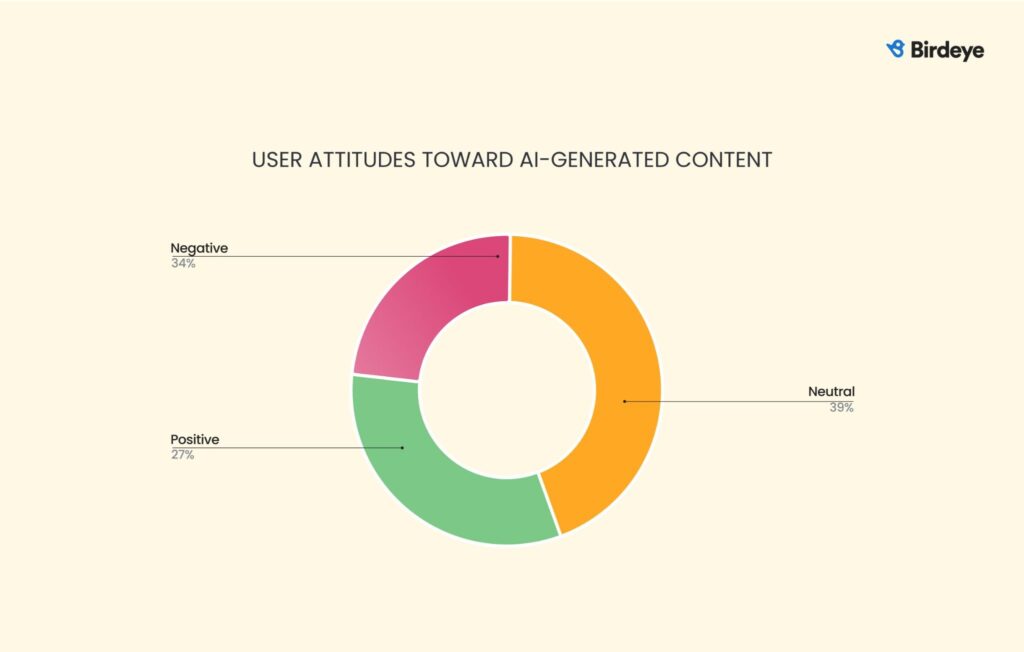
This neutrality creates space for differentiation: brands that use AI transparently and contextually can shift perceptions in their favor.
How customer sentiments towards AI change by platform
Sentiments towards AI also vary by platform. X (Twitter) and TikTok communities tend to be more open to AI-authored posts, while Facebook and Instagram users are more cautious.
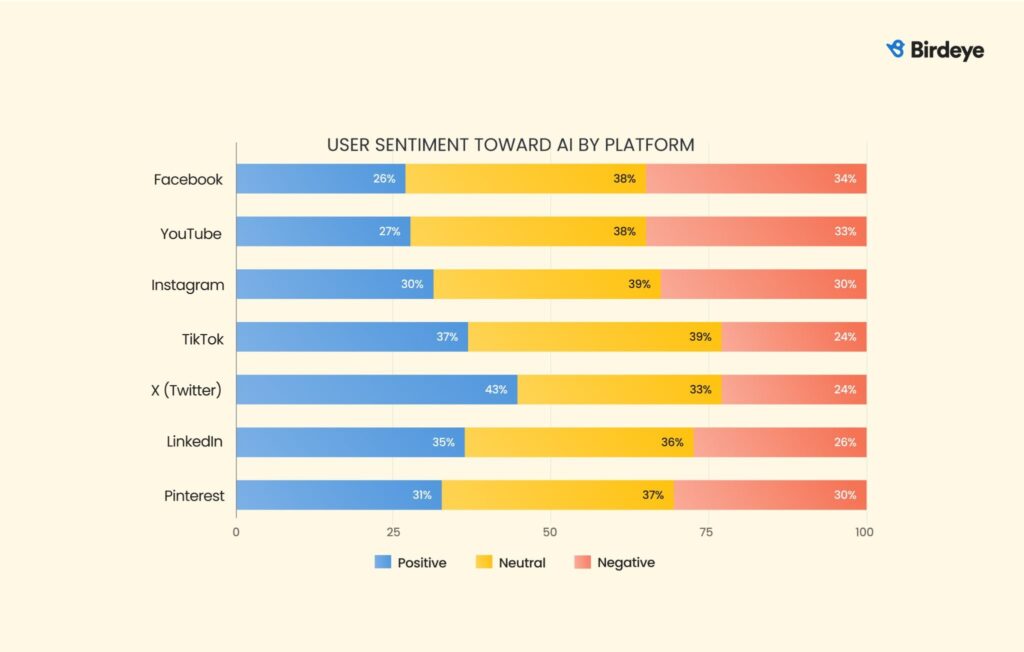
For brands, this means AI isn’t a one-size-fits-all solution. The level of disclosure, tone, and degree of human oversight should adapt to the platform’s specific needs. On spaces like TikTok, experimentation with AI-authored creativity may feel welcome, while on Facebook, transparency and careful moderation are key to maintaining trust.
How social teams feel about AI
Within organizations, teams tend to be more optimistic than individual consumers. Over half of social media professionals see AI as a net positive, citing its role in removing bottlenecks and allowing them to focus on higher-value creative work. Only a small minority view it as a threat to originality, suggesting teams are eager to lean into AI when it’s deployed thoughtfully.
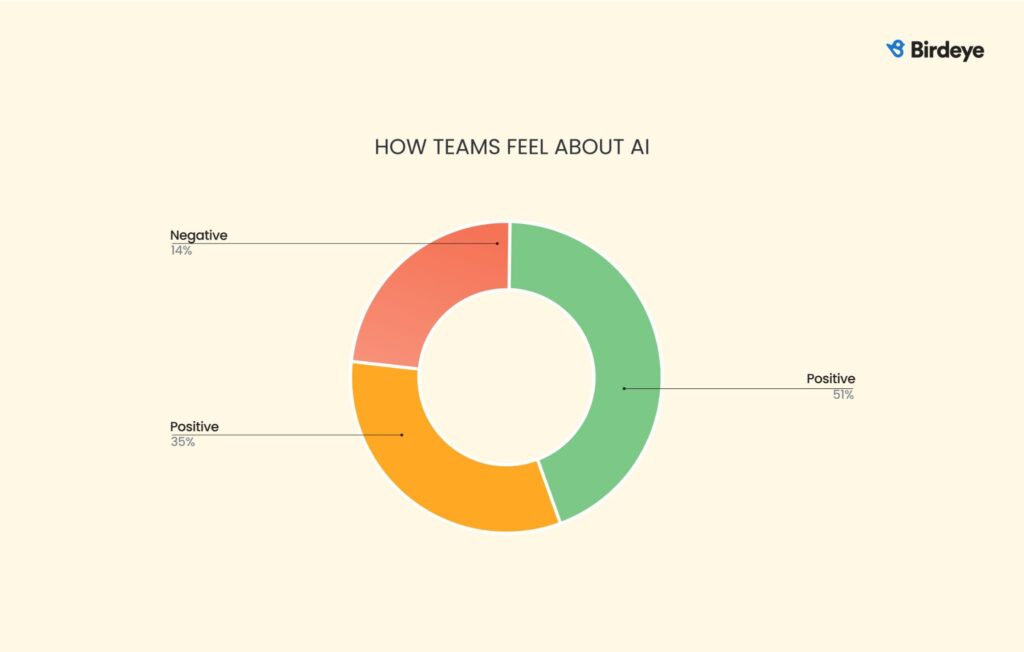
Put simply, AI is here to stay, but its success depends on how effectively brands strike a balance between efficiency and authenticity.
Five moves to build a modern content engine
- Anchor in daily vertical video. Algorithms prioritize the format: shoot on a phone, caption in-app, and publish.
- Close the reply-speed gap. An hour should be the SLA. Layer quick replies, chatbot triage, and smart alerts to hit it without burning staff out.
- Replace spreadsheets with a cloud scheduler. One asset library, combined with role-based permissions, allows local managers to swap relevant visuals without compromising the brand.
- Thread AI through three choke points. Prompt-based ideation, first-draft captions, and predictive send-time engines compound marginal gains over hundreds of posts.
- Measure what matters. Track engagement rate, follower velocity, and median response time on one dashboard so creative wins translate into board-level language.
FAQs
Our research shows that posting at least once a day is the baseline. Brands that publish daily vertical video formats like Reels or TikToks see stronger engagement and more consistent reach.
Short-form vertical video leads in engagement, followed by photos and Stories (see content format benchmarks above).
Consumers increasingly expect replies within an hour, much faster than most brands currently deliver (see benchmarks above).
Ideation remains the top bottleneck. Teams also struggle with fragmented workflows and manual processes, which slow down scaling efforts.
AI makes the biggest impact in ideation, caption drafting, and optimizing send times (see section above for examples).
Sentiments are mixed. Authenticity matters more than method: audiences embrace AI when it adds creativity or speed, but push back when it replaces human empathy in direct interactions.
Scale smarter with Birdeye Social AI
The pace of social change is only accelerating. Teams are being asked to do more with less, and the brands pulling ahead aren’t just working harder; they’re working smarter with the right tools.
Birdeye Social AI gives you that edge. It removes friction from everyday tasks, allowing your team to focus on creative work that actually moves the needle.
- Instant ideation: Type a prompt and receive dozens of on-brand post concepts, captions, and hashtag sets in seconds.
- Auto-optimized scheduling: Our AI pinpoints the precise minute your audience is most active on every network and queues posts automatically.
- Smart replies at scale: Draft personalized responses to comments and DMs in a single click while maintaining your brand voice.
- Unified calendar: Plan for all social media platforms from one dashboard, with location-level permissions for multi-unit teams.
- Real-time performance insights: Track engagement rate, follower velocity, and response-time median in a single view, and watch the platform adjust recommendations as trends change.
That’s the difference between keeping up and pulling ahead: smarter workflows today drive stronger brand growth tomorrow.
Are you ready to turn smarter workflows into stronger growth? Watch our free demo and see how Birdeye Social AI helps you scale without burning out your team.

Originally published
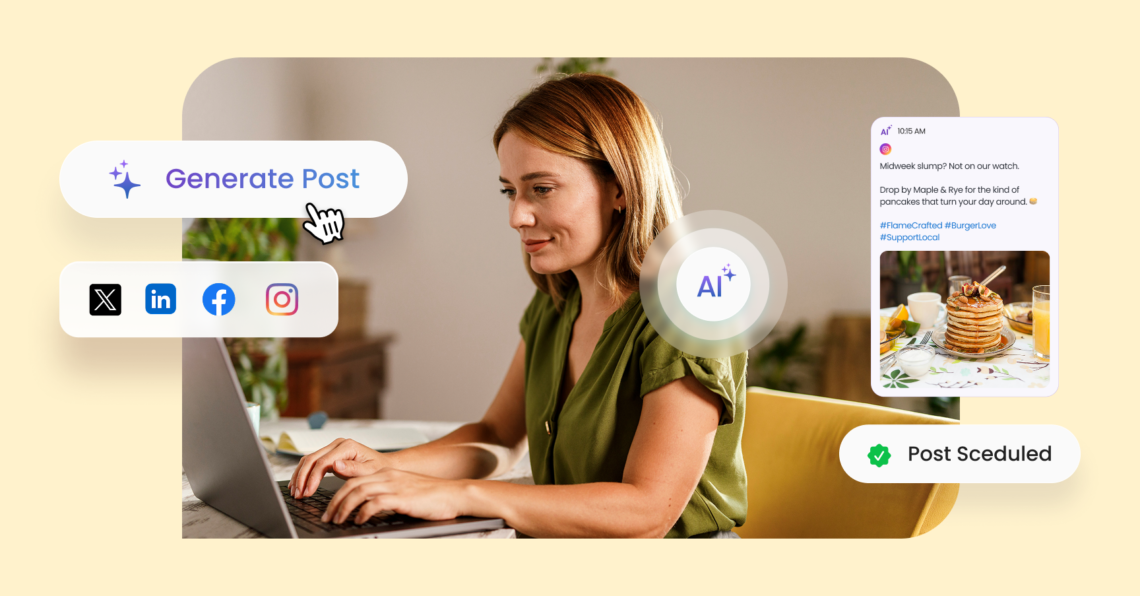

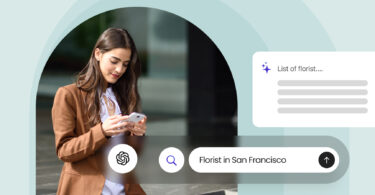
![[Feature image] How to Get Your Law Firm Found in AI Search](https://birdeye.com/blog/wp-content/uploads/Feature-image-How-to-Get-Your-Law-Firm-Found-in-AI-Search-375x195.jpg)




